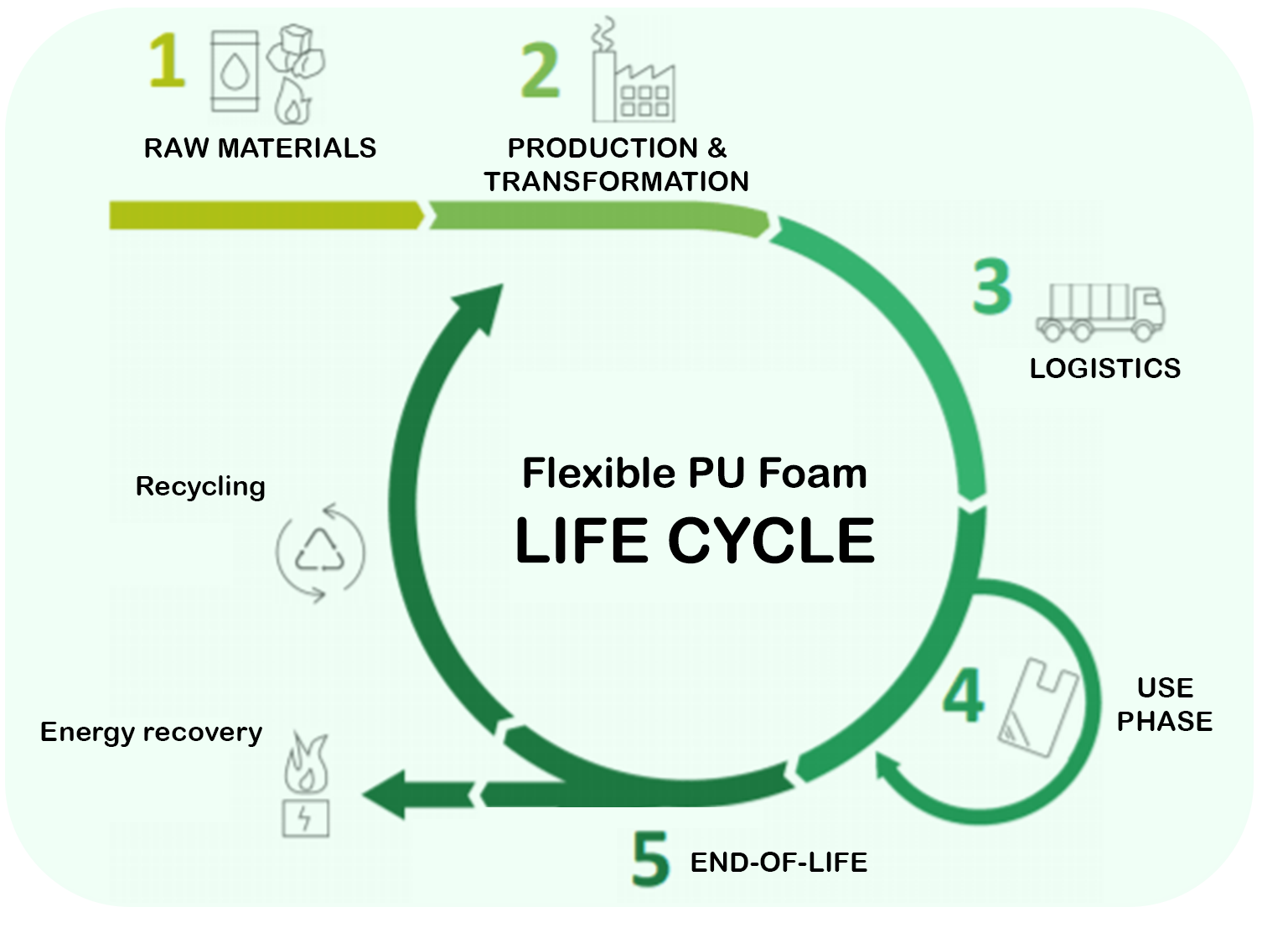SUSTAINABILITY
Flexible PU foam is a thermosetting polymer used in durable applications such as notably upholstered furniture, bedding and transportation. Like many other industries, the flexible PU foam has over the past decades sought to improve the environmental impact of its product. If one follows the life cycle of PU foam the following steps are where a difference can be made.

Raw Materials
Historically nearly all raw materials used for flexible PU foam production have been of fossil origin. This is still largely the case today but the situation is progressively changing with the increased use of alternative polyols, such as bio-polyols, recycled polyols and CO2-based polyols. Research is being carried out on producing diisocyanates from recycling origin too, but these substances are not available on an industrial market scale yet.
As a result, foams with bio-content have been available on the market for many years now and many producers have them in their portfolio. The first foams made with recycled polyols from post-consumer mattresses are available on the market since 2021. With the further construction of recycling factories, it is expected that more and more foams with recycled content will be available on the market soon.
Production & Transformation
A cradle-to-gate analysis of flexible PU foam (also called eco-profiles) shows that the impact of foam production on the life cycle of the product is minimal. This is not surprising because the foam industry is not a major energy consumer, as chemical reactions taking place in foam factories are exothermic.
This does not mean that action can not be undertaken to be improve the life cycle of foam also in production and transformation stage. Such an improvement can be supported by the usage of renewable energy, minimization of water usage and minimization of waste, notably via reduction or re-use of production cut-offs. Reduction of production cut-offs is made possible with latest digital technologies allowing to forecast which parts will be cut out of foam blocks even before the said blocks are produced. Re-use of production cut-offs in our industry has been practiced for decades, considering that such cut-offs are used as such (flakes in cushions) or agglomerated into rebounded foam used in carpet underlay, gym mats etc.
Logistics
Due to its cellular structure, flexible polyurethane foam is a lightweight material made mostly out of air. This explains why historically transporting foam over long distances was uneconomical and required to run trucks to transport relatively little foam. In the past decade, industry has developed technology and foam formulations allowing compression and rolling for storage and transportation. The famous bed-in-a-bow mattress is probably the best example of that. This allows a much higher utilization of transport and storage means.
Use Phase
Flexible PU foam is a durable material, made to last for the whole lifetime of the product that contains it. That is why you never have to change the foam in a mattress or a car seat and save resources by not having to procure replacement parts.
End-of-life
The post-consumer fate of flexible polyurethane foam is dependent on the fate on product that contains it. Today in Europe, a significant amount of furniture and mattresses are still being landfilled or incinerated. This is due to change in the near future with the progressive implementation of new EU waste legislation. When post-consumer mattresses and furniture are collected and dismantled in a clean and sound way, then recycling of polyurethane at its full potential becomes possible.
However, as a thermosetting polymer – and contrary to thermoplastics – PU foam cannot just be melted at the end of its useful life to make new products. This is why a variety of recycling technologies had to be developed. Our brochure about the End-of-life of flexible PU foam from mattresses and furniture provides for an overview of regulatory drivers, recycling technologies and remaining challenges in that area.
One may wonder why recycling efforts for polyurethanes focus on mattresses and furniture. The answer is relatively simple: the products themselves are relatively easy to dismantle and contain large amounts of PU foam. Recycling of foams from vehicles is for example more difficult, as small quantities are scattered in different places of the vehicle and not always easily accessible. Furthermore, end-of-life vehicle treatment, where the vehicle is thrown into a shredder, makes it impossible to recuperate foam that is not contaminated with oil or other liquids that were in the ELV.
For products that are too difficult to dismantle or too contaminated to recycle, waste-to-energy or thermochemical recycling are the best options. The latter technology in particular allows to produce new “virgin-equivalent” raw materials.
What does the future hold?
A tremendous amount of effort is currently being undertaken by the polyurethane supply chain to make polyurethane even more sustainable. This includes constant research into new raw materials, as well as the development of recycling technologies and infrastructure. It is expected that a significant amount of raw materials used in flexible PU foam production will be of recycled origin in the foreseeable future.
In 2022, the European Commission will propose a revision of the End-of-life Vehicles Directive. It is expected that the draft legal text will contain provisions on recycled content for the plastics fraction in vehicles, including PU foam. In the same vein, a new draft Regulation on eco-design will consider issues such as compulsory recycled content and products passporting. Over time, secondary legislation should make that regulation applicable also to mattresses and furniture. It is thus clear, that a market for recyclates of PU foam will be created by law.


